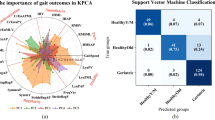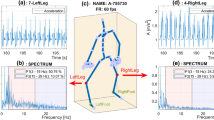Abstract
Antalgic gait is one of the most common abnormalities in human beings during the walking. This work presents a framework for the automatic recognition for antalgic and non-antalgic gaits, using the gyroscope of a smartphone for data acquisition. The test carried out was 10-meter walk, with a population of 30 subjects, 40% antalgics, and 60% non-antalgics; 80% was used in the training stage, and the rest for the test. A hypothesis testing and p-value method were developed to determine the statistical difference between both datasets and validate the usefulness of data in the features selection and classification approach. The classification algorithms used were: i) K-Nearest Neighbors (k-NN), ii) Naive Bayes (NB), iii) Support Vector Machines (SVM), iv) Discriminant Analysis (DA), v) Decision Trees (DT), and vi) Classification Ensembles (CE). The performance of the algorithms was evaluated using the metrics: Accuracy (ACC), Sensitivity (R), Specificity (SP), Precision (P), and F-measure (F). k-NN and SVM were the models with better performance with Accuracy of 99.44% and 98.88%, respectively. The obtained results allow to determine the feasibility of implementing this framework in real scenarios for its use in the improvement of diseases diagnosis and decision-making to antalgic gait diseases.
Access this chapter
Tax calculation will be finalised at checkout
Purchases are for personal use only
Similar content being viewed by others
References
Anguita, D., Ghio, A., Oneto, L., Parra, X., Reyes-Ortiz, J.L.: Human activity recognition on smartphones using a multiclass hardware-friendly support vector machine. In: Bravo, J., Hervás, R., Rodríguez, M. (eds.) IWAAL 2012. LNCS, vol. 7657, pp. 216–223. Springer, Heidelberg (2012). https://doi.org/10.1007/978-3-642-35395-6_30
Brahim, A., et al.: A decision support tool for early detection of knee osteoarthritis using x-ray imaging and machine learning: data from the osteoarthritis initiative. Comput. Med. Imaging Graph. 73, 11–18 (2019)
Brenton-Rule, A., Mattock, J., Carroll, M., et al.: Reliability of the tekscan matscan® system for the measurement of postural stability in older people with rheumatoid arthritis. J. Foot Ankle Res. 5(1), 21 (2012)
Connor, P., Ross, A.: Biometric recognition by gait: a survey of modalities and features. Comput. Vis. Image Underst. 167, 1–27 (2018)
Derawi, M., Bours, P.: Gait and activity recognition using commercial phones. Comput. Secur. 39, 137–144 (2013)
Fathima, S.S.S., Banu, W.R.: Abnormal walk identification for systems using gait patterns. Biomed. Res. India 27, S112–S117 (2016)
Frigui, H.: Clustering: algorithms and applications. In: 2008 First Workshops on Image Processing Theory, Tools and Applications, pp. 1–11. IEEE (2008)
Gafurov, D., Helkala, K., Søndrol, T.: Gait recognition using acceleration from mems. In: First International Conference on Availability, Reliability and Security (ARES 2006), p. 6. IEEE (2006)
Gafurov, D., Snekkenes, E., Bours, P.: Gait authentication and identification using wearable accelerometer sensor. In: 2007 IEEE Workshop on Automatic Identification Advanced Technologies, pp. 220–225. IEEE (2007)
Gu, X., Deligianni, F., Lo, B., Chen, W., Yang, G.Z.: Markerless gait analysis based on a single RGB camera. In: 2018 IEEE 15th International Conference on Wearable and Implantable Body Sensor Networks (BSN), pp. 42–45. IEEE (2018)
Hoang, T., Nguyen, T., Luong, C., Do, S., Choi, D.: Adaptive cross-device gait recognition using a mobile accelerometer. J. Inf. Process. Syst. 9(2), 333–348 (2013)
Jun, K., Lee, Y., Lee, S., Lee, D.W., Kim, M.S.: Pathological gait classification using kinect v2 and gated recurrent neural networks. IEEE Access 8, 139881–139891 (2020)
Khera, P., Kumar, N.: Role of machine learning in gait analysis: a review. J. Med. Eng. Technol. 44(8), 441–467 (2020)
Kitade, I., et al.: Kinematic, kinetic, and musculoskeletal modeling analysis of gait in patients with cervical myelopathy using a severity classification. Spine J. 20(7), 1096–1105 (2020)
Kokkotis, C., Moustakidis, S., Papageorgiou, E., Giakas, G., Tsaopoulos, D.: Machine learning in knee osteoarthritis: a review. Osteoarthritis Cartilage Open, 100069 (2020)
Kozlow, P., Abid, N., Yanushkevich, S.: Gait type analysis using dynamic Bayesian networks. Sensors 18(10), 3329 (2018)
MathWorks, I.: Heart sound classifier. https://la.mathworks.com/matlabcentral/ /fileexchange/65286-heart-sound-classifier (2021). Accessed 06 Apr 2021
Nair, S.S., French, R.M., Laroche, D., Thomas, E.: The application of machine learning algorithms to the analysis of electromyographic patterns from arthritic patients. IEEE Trans. Neural Syst. Rehab. Eng. 18(2), 174–184 (2009)
Ngo, T.T., Makihara, Y., Nagahara, H., Mukaigawa, Y., Yagi, Y.: The largest inertial sensor-based gait database and performance evaluation of gait-based personal authentication. Pattern Recogn. 47(1), 228–237 (2014)
Paluszek, M., Thomas, S.: MATLAB Machine Learning. Apress, New York (2016)
Physiopedia: 10 metre walk test. https://physio-pedia.com.html (2021). Accessed 19 June 2021
Recher, F., Banos, O., Nikamp, C.D., Schaake, L., Baten, C.T., Buurkc, J.H.: Optimizing activity recognition in stroke survivors for wearable exoskeletons. In: 2018 7th IEEE International Conference on Biomedical Robotics and Biomechatronics (Biorob), pp. 173–178. IEEE (2018)
Rong, L., Jianzhong, Z., Ming, L., Xiangfeng, H.: A wearable acceleration sensor system for gait recognition. In: 2007 2nd IEEE Conference on Industrial Electronics and Applications, pp. 2654–2659. IEEE (2007)
Sharif Bidabadi, S., Tan, T., Murray, I., Lee, G.: Tracking foot drop recovery following lumbar-spine surgery, applying multiclass gait classification using machine learning techniques. Sensors 19(11), 2542 (2019)
Singh, J.P., Jain, S., Arora, S., Singh, U.P.: Vision-based gait recognition: a survey. IEEE Access 6, 70497–70527 (2018)
Wan, C., Wang, L., Phoha, V.V.: A survey on gait recognition. ACM Comput. Surv. (CSUR) 51(5), 1–35 (2018)
Whittle, M.W.: Gait Analysis: An Introduction. Butterworth-Heinemann, UK (2014)
Zhan, A., et al.: Using smartphones and machine learning to quantify Parkinson disease severity: the mobile Parkinson disease score. JAMA Neurol. 75(7), 876–880 (2018)
Author information
Authors and Affiliations
Corresponding author
Editor information
Editors and Affiliations
Rights and permissions
Copyright information
© 2021 Springer Nature Switzerland AG
About this paper
Cite this paper
Gonzalez-Islas, JC., Dominguez-Ramirez, OA., Lopez-Ortega, O., Paredes-Bautista, RD., Diazgiron-Aguilar, D. (2021). Machine Learning Framework for Antalgic Gait Recognition Based on Human Activity. In: Batyrshin, I., Gelbukh, A., Sidorov, G. (eds) Advances in Soft Computing. MICAI 2021. Lecture Notes in Computer Science(), vol 13068. Springer, Cham. https://doi.org/10.1007/978-3-030-89820-5_19
Download citation
DOI: https://doi.org/10.1007/978-3-030-89820-5_19
Published:
Publisher Name: Springer, Cham
Print ISBN: 978-3-030-89819-9
Online ISBN: 978-3-030-89820-5
eBook Packages: Computer ScienceComputer Science (R0)




